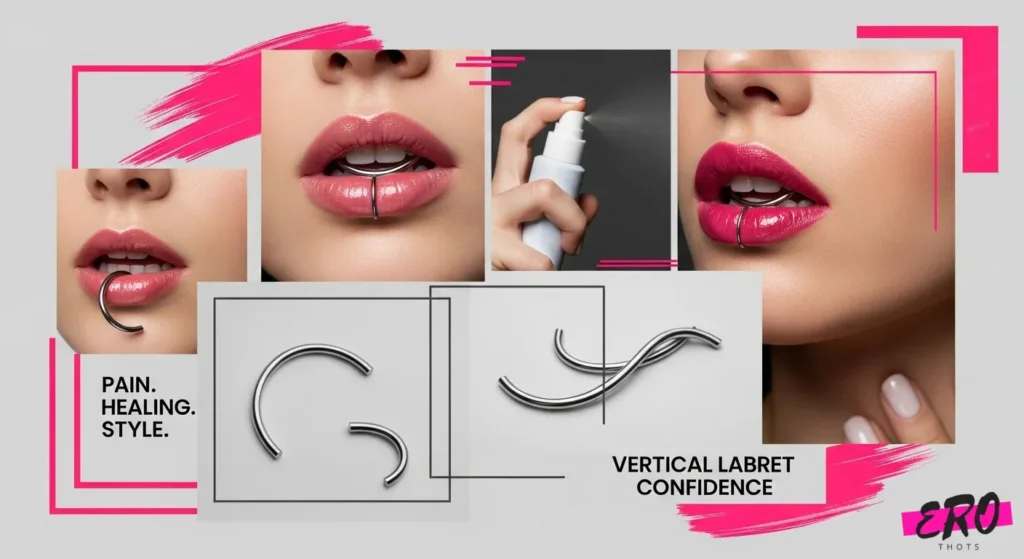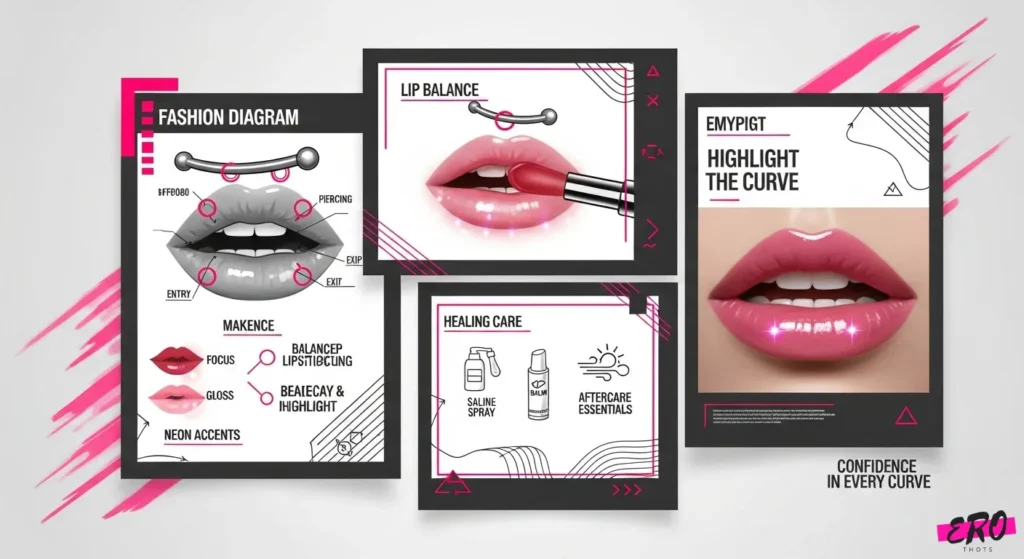
Vertical Labret Piercing Pain, Healing, and Aesthetic no fluff handbook for everything from “how much will it hurt” to “how do I make this look amazing on camera” You’ll get a realistic pain picture, a science backed healing plan, styling ideas that actually work in real life, and a clear comparison with three popular guides so you can see how this post goes further. A vertical labret is a lip piercing that passes vertically through the center of the lower lip, with one ball visible on the top of the lip and the other on the underside. It is distinct from a traditional labret, which exists inside the mouth.
What A Vertical Labret Piercing
A vertical labret piercing passes through the bottom lip vertically so both ends of the jewelry are visible, one on the vermilion (the pink of your lip) and one just beneath it. Most piercers use a curved barbell so the jewelry follows the shape of your lip and moves comfortably when you speak, eat, and smile. Many studio guides describe it this way and recommend curved barbells specifically because they fit the lip’s contour.
Pain, But Realistically
On the classic “one-to-ten” pain scale, most people report moderate, short-lived discomfort more “pinch and pressure” than “agony.” Several mainstream resources and lived experiences align on this: the initial moment stings, then it settles quickly. Health publishers and experienced piercers alike note brief swelling and throbbing in the first days, which is normal.
The First Week What Feels Normal
Expect swelling, warmth, and tenderness for a few days. That’s your body doing routine cleanup. If you notice severe or worsening pain, heavy bleeding, or unusual discharge, that’s not routine, get a professional to check it. This escalation guideline comes straight from medical consumer health guidance on lip piercings.
Healing Timeline The Honest Version
You’ll see two common timelines online: a “fast” 6–8 weeks to feel settled and a “longer” 3–6 months to be genuinely robust. Studios often cite the shorter window because mouth tissue is highly vascular and appears to calm quickly. Many professional shops and seasoned piercers also warn that full internal remodeling can take months even after it looks fine on the surface. Plan your life around the longer window especially if you intend to swap jewelry frequently.
What To Expect By Phase
Below is a simple map you can screenshot and follow. It blends what piercers, health writers, and long-term wearers observe most often.
| Phase | What You Usually Feel | What You Usually Do | Red Flags To Watch |
| Days 1–3 | Noticeable swelling, warmth, mild throbbing | Cold compresses outside lip, very gentle saline care, soft foods | Bleeding that won’t stop, intense pain, feverish feeling |
| Days 4–14 | Swelling slowly drops, tenderness on bumping | Keep up saline, avoid oral irritation, sleep on your back | Worsening redness, hot streaking, foul discharge |
| Weeks 3–8 | Feels almost normal but still sensitive | Discuss a downsize with your piercer once swelling’s gone | Jewelry embedding, persistent sharp pain |
| Months 3–6 | Fully settled, stable to change jewelry | Resume most activities, continue gentle hygiene | New swelling after a knock, non-healing irritation |
Aftercare That Works In Real Life
Keep it simple and consistent: twice-daily sterile saline, air-drying afterward, and hands off unless you’re cleaning. Avoid alcohol-based mouthwashes during the early weeks they’re harsh and be careful with spicy foods and piping-hot drinks while the tissue is puffy. Studio and community guidance repeatedly reinforce gentle saline and minimal fiddling as the backbone of lip aftercare.
The Saline Routine, Demystified
A good routine looks like this: spray sterile saline, give it a minute to soften any buildup, gently wipe the outside with clean gauze or a cotton swab, then lightly spritz again and let it air-dry. You’re not trying to “scrub it clean.” You’re trying to keep it calm. Piercing educators emphasize “soften, wipe, air-dry” rather than aggressive cleaning.
Managing Swelling Without Overdoing It
Use brief cold compresses on the outside of the lip and sip cool water. Let hot drinks cool; steam heat plus lip movement can make things grumpier on day two or three. Several professional aftercare pages suggest icing strategies and temperature caution for early swelling control.
Your piercer will start you with a longer curved barbell to give swelling space. Once the puffiness is gone, a shorter bar helps reduce snagging and irritation. Many wearers report a noticeable comfort upgrade right after downsizing, typically around the four-week mark if healing is on track. Community experience repeatedly notes symptom relief after the first downsize.
Jewelry Materials “Quiet Skin” Choices
Implant-grade titanium or high-quality steel with smooth, internally threaded or threadless ends is your low-drama option. Poorly finished or plastic jewelry is more likely to irritate or harbor bacteria. Reputable retailers and forum moderators consistently nudge new wearers toward implant-grade titanium curved barbells for vertical labrets.
Gauge, Length, And Shape What Fits Most Lips
Many vertical labrets are pierced at 16g with an initial bar long enough to accommodate swelling; curved barbells sit more naturally than straight ones on the lip’s arc. Specialty stores stock a wide range of lengths and styles so your piercer can tune the fit for your anatomy instead of forcing a one-size-fits-all solution.
Eating, Drinking, And Talking First Two Weeks
Soft, cool foods are your friend. Hydration matters. Bite slowly until your lip’s proprioception catches up to the new jewelry. Skip alcohol for a bit; it dries tissues and can sting. Several studio resources advise temperature caution and gentle habits until swelling is down.
Kissing And Intimacy
You can kiss with a vertical labret, but communicate and move gently at first. Many partners barely notice once you’ve adjusted, especially with smooth or bezel-set ends that don’t catch. Real-world reports say the “learning curve” is short and the experience becomes natural quickly.
Makeup, Photos, And Everyday Style

A vertical labret naturally draws the eye to the cupid’s bow and lower lip curve. For a clean look, think of balance if you wear a bold upper-lip color, try a smaller top end; if you want the jewelry to pop, choose a bright gem or high-polish top and keep lip color sheer. A little lip balm helps reduce dry “flaking” around the top exit when you’re outside in wind or sun apply around, not over, the piercing during healing.
Work And Video Calls Low Drama Strategies
If your workplace is conservative, opt for a low-profile top end in a mirror-finish titanium and keep the lower end subtle. On camera, a 2–3 mm gem or dome end reads crisp without stealing the frame. If you need maximum discretion during healing, a satin-finish dome creates less glare than a faceted gem under overhead office lighting.
A small, tender bump after a snag or a rough sleep is common during the settling phase. Calm it down with diligent saline, zero twisting, and a chat with your piercer if it lingers. If swelling increases or the skin looks angry or shiny-tight, book that check-in sooner rather than later. Health guidance on facial piercings underscores getting evaluated when symptoms escalate instead of waiting it out.
When To Change Jewelry Patience Pays
It’s tempting to swap ends as soon as it looks calm, but give yourself a conservative runway. Many shops say it seems fine at 6–8 weeks; many pros and experienced wearers prefer waiting a full 3–6 months for a “behaves-no-matter-what” piercing before frequent changes. When in doubt, ask your piercer to do the first switch.
Sleeping face-down can press the jewelry into your lip. For the first few weeks, a slightly elevated back-sleeping setup reduces morning puffiness and accidental pressure. That small tweak alone prevents a lot of “why is it grumpy again?” mornings.
Oral Hygiene, But Gently
Brush as normal, but slow down near the jewelry. Rinse with clean water after meals, then do your saline later and don’t stack strong products. Alcohol-heavy mouthwashes can sting and dry the tissue in early healing, so stick to alcohol-free if you feel you need a rinse beyond water.
Plenty of water, steady protein, and mineral-rich foods support tissue repair. Cutting back on alcohol and high-sodium meals in the first week helps swelling normalize faster. This won’t replace aftercare, but it makes your body’s job easier.
Budget for the initial piercing, a follow-up downsize visit, and at least one high-quality jewelry upgrade once fully healed. Good jewelry lasts years, so spending more once is cheaper than buying “cheap, again and again.”
FAQs
Does a vertical labret piercing hurt a lot?
It’s a sharp pinch that fades quickly for most people. Expect tenderness for a few days; severe, persistent pain is a sign to call a pro.
How long does healing really take?
Plan your life for 3–6 months for full, stable healing even if it looks calm in 6–8 weeks. Your lip may feel normal early, but deeper tissue is still maturing.
When should I downsize my jewelry?
Usually after swelling subsides, often around week four, but only a piercer can confirm timing for your anatomy. Many people feel immediate comfort after downsizing.
What jewelry material is best?
Implant-grade titanium or high-quality steel with internally threaded or threadless ends keeps irritation low and surfaces smooth.
Can I kiss with a vertical labret?
Yes, go slow, communicate, and consider smoother ends. Most partners adjust quickly and barely notice it.
What are early red flags?
Escalating pain, thick yellow-green discharge, hot spreading redness, feverish feelings, or bleeding that won’t stop. That’s the time for a professional check.
Final Word
If you want a piercing that flatters the lip’s natural curve and photographs beautifully, a vertical labret is a strong choice. Go in with realistic pain expectations, treat the first week like a recovery micro-project, lean on your piercer for a timely downsize, and style it to fit your life subtle for work, reflective for nights out, and bezel-smooth for cozy kisses. Heal it patiently, and it’ll love you back.
